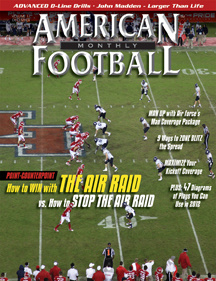Article CategoriesAFM Magazine
|
Maximizing Your Kickoff Coverage – Each player must possess a different skill set to ensure effective kickoff coverage.by: Ron PlanzSpecial Teams Coach • Minnesota State University, Mankato © More from this issue In order to maximize your kickoff coverage, each player must possess a different skill set and be committed to a ‘Want’ philosophy. At Minnesota State University, we take our special teams very seriously. We dedicate significant meeting time and practice to special teams every day. We film both angles of all phases, including when we do individual drill work for a specific unit. Our philosophy for special teams is very basic:
|
|
|||||||
| HOME |
MAGAZINE |
SUBSCRIBE | ONLINE COLUMNISTS | COACHING VIDEOS |
Copyright 2026, AmericanFootballMonthly.com
All Rights Reserved





